Transvaal Scottish Regiment
The Transvaal Scottish Regiment (Solomon Mahlangu Regiment) is an infantry regiment of the South African Army. As a reserve unit, it has a status roughly equivalent to that of a British Army Reserve or United States Army National Guard unit.
| The Transvaal Scottish | |||||||||||||||||
|---|---|---|---|---|---|---|---|---|---|---|---|---|---|---|---|---|---|
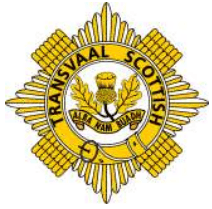 SANDF Transvaal Scottish emblem | |||||||||||||||||
| Active | 1902 to present | ||||||||||||||||
| Country | |||||||||||||||||
| Allegiance |
| ||||||||||||||||
| Branch |
| ||||||||||||||||
| Type | Line infantry | ||||||||||||||||
| Role | Motorised infantry | ||||||||||||||||
| Size | One battalion | ||||||||||||||||
| Part of |
| ||||||||||||||||
| Garrison/HQ | The View, Parktown Johannesburg | ||||||||||||||||
| Motto(s) | Alba nam Buadh (Scotland, Home of the Virtues) | ||||||||||||||||
| March | The Atholl Highlanders | ||||||||||||||||
| Battle honours |
| ||||||||||||||||
| Commanders | |||||||||||||||||
| Current commander | Lt Col D.D. Smythe JCD[1] | ||||||||||||||||
| Insignia | |||||||||||||||||
| Company level Insignia | 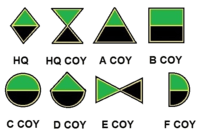 | ||||||||||||||||
| SA Motorised Infantry beret bar circa 1992 |  SA Motorised Infantry beret bar | ||||||||||||||||
History
Origin
John Murray, Marquis of Tullibardine, who later became the 7th Duke of Atholl, established the regiment after the conclusion of the Second Anglo-Boer War in 1902. Its initial membership consisted of volunteers from Scottish units that had fought in the war who chose to demobilise and remain in the colony. The new unit wore his family tartan and took the form of an oversized battalion with companies in a number of major Transvaal towns.
Bambatha Rebellion
The unit first saw service during the Bambatha Rebellion. "C" company of the Natal Rangers was recruited from men of the Transvaal Scottish Regiment (then called the Transvaal Scottish Volunteers).
Maritz Rebellion
In 1914 during the Maritz Rebellion, when men who supported the recreation of a Boer South African Republic rose up against the newly created government of the Union of South Africa, the Regiment was called up once again and saw action suffering one casualty.
World War One
German South West Africa
After the official outbreak of the First World War the Transvaal Scottish took part in the invasion of German South West Africa as part of the South-West Africa Campaign in late 1914 with a second battalion (2nd Transvaal Scottish) being raised for the campaign.
Their most serious encounter with German Forces took place near Trekkoppies when a superior German Force attacked 2nd Battalion. They suffered their first casualties of the war with 2 killed and 13 wounded. After the conquest of German South West Africa the 2nd Battalion was disbanded, while 1 Transvaal Scottish spent the remainder of the war in reserve.[2]
Western Front
To join British Imperial Forces for the war in Europe, 4th South African Infantry Regiment was raised (also known as the South African Scottish) because the 1912 Defence Act restricted the Active Citizen Force from operating outside of South Africa. This was a kilted unit wearing the Murray of Atholl tartan and two companies were drawn from members of the Transvaal Scottish.
After a short campaign in North Africa against a Turkish attack on the Suez Canal in 1915, the SA Scottish were sent to France. Here they took part in the Battle of Delville Wood as part of the Battle of the Somme in 1916. In the days between 15 July and 19 July the total casualty rate was at 74 percent of those who had gone into action. By the end of July the South African Scottish suffered 868 casualties. The final German forces were driven from Delville Wood after an Allied assault on 3 September 1916. After Delville Wood the shattered SA Scottish were reformed and served on the Western front, in particular at Vimy Ridge, the Somme, the Battle of Passchendaele, Marrieres Wood and the Battle of Messines. During its time on the Western Front, the South African Brigade and its Scottish heritage 4th Battalion, first served a lengthy stint with the British 9th (Scottish) Division, and following the Brigade's decimation in March 1918, was reconstituted and incorporated in September into the 66th (2nd East Lancashire) Division until the end of the war.[3]
East African Campaign
Other members of the Transvaal Scottish saw service in the Scottish company of the 9th SA Infantry ACF in the East African Campaign. After the conclusion of hostilities at the end of World War I members of the Regiment returned home and after demobilisation, continued with their civilian lives.
Inter-war Period
The Transvaal Scottish Regiment was once again called up in 1922 to help maintain law and order and quell the armed uprising of miners during the Rand Rebellion. In one encounter near Boksburg 12 members of the Transvaal Scottish, including an officer, were killed. The Regiment along with the Witwatersrand Rifles and the Royal Durban Light Infantry, cleared Fordsburg of the last rebels on 14 March 1922. By the end of the revolt another 5 had lost their lives and 60 had been wounded.
World War II
In 1936, 2 Battalion was raised once again in anticipation of World War II and when war finally broke out in 1939 a third battalion was formed.
The 1st Transvaal Scottish took part in the Allied offensive during the East African Campaign in order to take Italian East Africa (modern day Ethiopia and parts of Somalia). They engaged Italian forces in several engagement in Addis Ababa, Combolcia, Dessie and finally at their mountain fortress at Amba Alagi. The battalion was next sent to Egypt, to take part in the relief of Tobruk. In November 1941 the 1st Brigade, with which 1 Transvaal Scottish was serving, was attacked by a strong German force at Taib-el-Essemand, but successfully repulsed the attack.
In 1942 in the Battle of Gazala the 1st battalion defended against several attacks on the Gazala Line before joining the Eighth Army's retreat to the Alamein Line in Egypt, although a portion of the battalion was trapped and taken prisoner at Tobruk in June 1942. 1 Transvaal Scottish now joined the British Eight Army in the Second Battle of El Alamein where they halted the German assault on Egypt. Early in 1943 the battalion returned home to South Africa. There the unit was converted to armour, joining 1st SA Armoured Brigade.
In North Africa the 2nd Transvaal Scottish, together with two battalions consisting of members of the South African Police, served in the 6th South African Infantry Brigade. They assisted in the construction of the famous "Alamein Box". 6th South African Infantry Brigade attacked the fortified town of Sollum on 11 January 1942 as part of Operation Battleaxe and went on to fight in the battles of Bardia, Acroma Keep and Gazala. At Bardia, Sollum and Halfaya both German and Italian troops were forced to surrender to the Brigade. The majority of the battalion, along with the entire South African 2nd Division, was captured when the "fortress" of Tobruk fell at the end of the Battle of Gazala.[4]
3rd Transvaal Scottish took part in the East African Campaign in Ethiopia, in particular the three-day attack on Mega, Ethiopia. After this the battalion was sent to Egypt to take part in Operation Crusader, where it suffered heavy losses at the battle of Sidi Rezegh in November 1941. After Sidi Rezegh, 3rd Transvaal Scottish was temporarily disbanded. Over two hundred men from the Transvaal Scottish died in World War 2.[5]
Members of 3rd Transvaal Scottish who were captured in North Africa were shipped to occupied Europe. Some were on the merchant ship Sebastiano Veniero when the Royal Navy submarine HMS Porpoise sank her off the Greek coast in December 1941. Sebastiano Veniero's crew beached the ship at Methoni in the Peloponnese, where many of the PoWs took their chances to swim ashore. A 3rd Transvaal Scottish lance corporal, Bernard Friedlander, swam ashore with a rope, which took him 90 minutes. The rope was then used to haul a cable ashore, which was made fast on land and used by nearly 1,600 survivors to reach safety.[6] In July 1945 Friedlander was awarded the George Medal.[7] In 1947 King George VI toured South Africa, and at a ceremony in Johannesburg on 31 March personally decorated Friedlander with the medal.[6]
Post-war 1945-1974
All three battalions were reconstituted in 1946, with the 3rd battalion being converted to artillery as 7th Medium Regiment (3TS). This unit was disbanded in 1959 and many members were transferred back to the Transvaal Scottish. Earlier, in 1953, the 1st and 2nd battalions had been amalgamated, although in 1971 the 2nd Battalion Transvaal Scottish was once again revived.
South African Border War
After the Portuguese withdrew from Angola in 1975, Civil War broke out in the country and 1st Battalion Transvaal Scottish was deployed in southern Angola from South-West Africa. Later in the same year the 2nd Battalion deployed to the Caprivi Strip where they would eventually help develop a form of highly mobile counter-insurgency operations (COIN-ops) using Mine Protected Vehicles throughout the war.
In 1983, Company Sergeant-Major Trevor ("Porky") Wright was awarded the Honoris Crux after he distinguished himself when his isolated company base in north-western South-West Africa was attacked by heavily guerilla fighters. Wright personally firing a machine gun from the hip at one point and supervised ammunition replenishment throughout the course of the enemy attack. (A number of other members of the Company were awarded the CSADF medal for their brave and heroic actions, now known as the Military Merit Medal. One of these members 2lt Lance Houghton went on to command the 2 Battalion in 1992). Another event CSM Wright was involved in, occurred two years prior to the attack, was also brought into consideration for the commendation. Wright noticed a primed hand grenade which had been accidentally lobbed near his fellow troops during training and risked certain death when he picked up and hurled the grenade away. In 1984 a company led by Captain George Brownlow from 2 Transvaal Scottish achieved notable successes with the capture of two insurgents. Captain Brownlow was later awarded Southern Cross Medal. In the 1980s 2 Transvaal Scottish became the first Citizen Force unit to deploy on the borders with Botswana and Zimbabwe.
The Transvaal Scottish was assigned to command of 72 Brigade in this era.
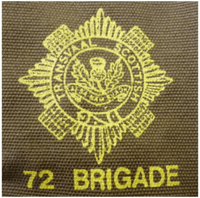
The 1990s
Later in the early 1990s, when the negotiations to end apartheid in South Africa were taking place, 1st and 2nd Transvaal Scottish were assigned internal stability roles in townships where unrest and violence broke out.
The regiment's last major service was to remain on standby throughout the country's first fully democratic elections on 27 April 1994. The Transvaal Scottish had helped assure the peaceful transition to democracy, and with it, signalled their own willingness to build a new South Africa. During 1997 as a result of the rationalisation measures within the South African National Defence Force the 1st and 2nd Battalions of the Regiment were once again amalgamated.
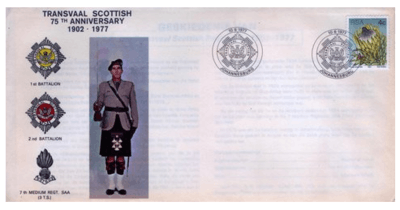
In 1995 a 44-strong Transvaal Scottish party visited the battlefields of the Somme in France, their former Colonel-in-Chief, Queen Elizabeth the Queen Mother, their allied regiment The Black Watch as well as the Atholl Highlanders and their clan chief, Iain Murray, 10th Duke of Atholl, at Blair Castle in Scotland. In the party was Lt. Bruce Murray and his brother, Cpl. Lord Murray, both relatives of the Duke of Atholl.
The 21st Century
On 4 August 2000, a regimental colour party took part in a parade in London to celebrate the one hundredth birthday of Queen Elizabeth the Queen Mother and in 2002 representatives of the regiment returned to London for the funeral of their former Colonel-in-Chief. In 2002 the Regiment celebrated 100 years of service with a colour parade at King Edward VII School in Parktown, Johannesburg.
Difficulties in obtaining the normal level of funding to carry on peacetime activities of recruitment and training saw a decline in the activities of the Regiment in the years immediately following 2002. Under the guidance of the current Commanding Officer of the Regiment, Lieutenant Colonel Don Smythe JCD, the Regiment has in recent years overcome a number of obstacles and is again fulfilling an active role within the South African National Defence Force. The Red Hackle, worn for over 70 years by soldiers of the Transvaal Scottish, is once again regaining its place of prominence on parades as well as on active service duties.
Since 2007 members of the Regiment have taken an active part in United Nations peace keeping operations in Burundi and the Democratic Republic of Congo.
"A" company of the Transvaal Scottish was deployed in 2010 to take part in the United Nations Mission in Sudan, while "B" Company was deployed to defend the country's borders.
Building on the hard work and success of the past few years the Regiment is currently in the process of raising and training "C" Company.[8]
The Regimental headquarters are now in The View, Parktown, originally the house of Sir Thomas Cullinan.
Name Change
In August 2019, 52 units of the Reserve Force had their names changed to reflect the current diversity of the current SANDF.[9]
This unit's name is planned to be changed to Solomon Mahlangu Regiment in honor of the activtist who joined the ranks of the uMkhonto we Sizwe in the mid-1970s.
Regimental symbols
- The regimental tartan is the "Murray of Atholl", except for the pipers who wear the "Murray of Tullibardine". Both tartans symbolise the regiment's connections to the Dukes of Atholl, and thus to the Atholl Highlanders. Since 1938, members have worn the red hackle on their khaki tam o'shanter as a symbol of the regiment's connection with the famous Black Watch Regiment. As part of their formal uniforms, officers and Warrant Officers Class I of the regiment carry Basket-hilted claymores instead of the more typical swords.
- The regimental badge depicts a Scottish thistle on a scroll bearing the motto Alba nam Buadh (Gaelic for "Well done, Scotland" or "Scotland, home of the virtues"). It is surrounded by a heraldic strap and buckle bearing the regiment's name, all on the Star of the Order of the Thistle.
- The regimental March is the "Atholl Highlanders".
Previous Dress Insignia
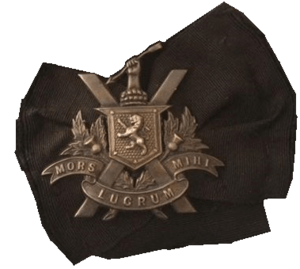
During WW1 the Union Defence Force established the 4th Infantry Regiment which was unique in that it was the South African Scottish, raised from the Transvaal Scottish and the Cape Town Highlanders, and wearing the Atholl Murray tartan. This regiment's collar badges were identical to those of the Cape Town Highlanders but bore the Latin motto "Mors Lucrum Mihi" (Death is my reward) in place of the usual Cape Town Highlander wording. (Death is my Reward), was the family motto of the first Officer Commanding SA Scottish, a Lieutenant-Colonel F.A. Jones.
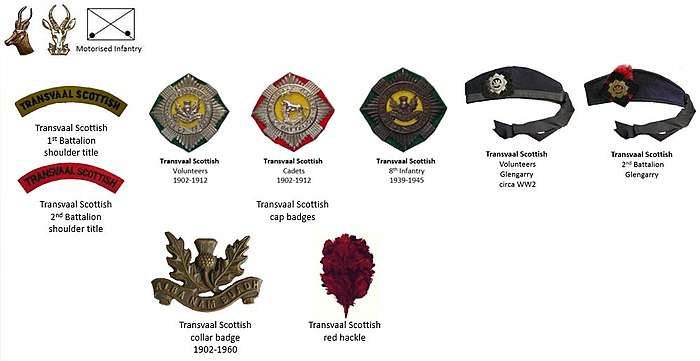
Current Dress Insignia
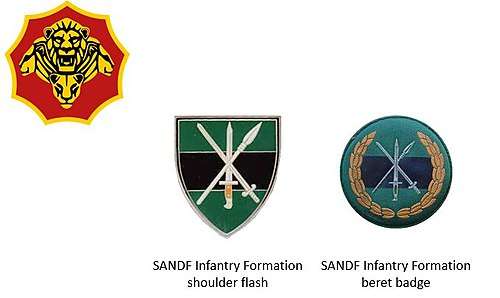
Alliances
Sister regiments
3 Battalion Transvaal Scottish was converted to 7 Medium Artillery Regiment and garrisoned in Benoni.
Battle honours
The Transvaal Scottish has the following battle honours on its regimental colours:
- Natal 1906
- South West Africa, 1914-1915
- East Africa (As part of the 1st Infantry Division and then later, as part of the independent 1st South African Infantry Brigade) 1940 - 1941
- El Wak
- The Juba
- Yonte
- Diredawa
- Combolcia
- Amba Alagi
- Western Desert (As part of the 1st Infantry Division) 1941-1943
- Sollum
- Sidi Rezegh
- Gazala
- Alem Hamza
- Acroma Keep
- Alamein Defence
- Mega
- El Alamein
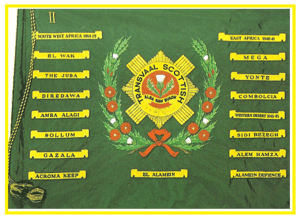
In addition, the regiment (along with the Cape Town Highlanders Regiment) still claims fifteen "missing" battle honours awarded for service in France and Flanders to the 4th South African Infantry (South African Scottish) battalion; these include some of the most famous in South Africa's military history:
- Egypt 1916
- Somme 1916
- Delville Wood
- Arras 1917
- Ypres 1917
- Menin Road
- Messines 1918
- Hindenburg Line
- Cambrai 1918
- Pursuit to Mons
- France and Flanders 1918
- Le Transloy
- Scarpe 1917
- Kemmel
- Lys
Transvaal Scottish Pipes & Drums
The Transvaal Scottish Pipes and Drums is South Africa's premier Pipe Band. Formed in 1902, the band is one of South Africa’s most recognised and followed Pipe Bands.
Fondly known as the ‘Jocks’, the Transvaal Scottish Pipes and Drums have won the premier division of the South African championships on numerous previous occasions and, in 2019, were crowned the best pipe band in South Africa, the South African Champions and the Champion of Champions. Acknowledged, both locally and internationally, for the exceedingly high standards of their performances and for the quality and professionalism of their musicians, many of the band members are also national solo champions in their own right.
Consisting of pipers and drummers, the band is made up of students and professionals, coming together to develop and fine-tune their skills and to enjoy a hobby, based on a common passion for all things Celtic.
The drummers of the band proudly wear the Murray of Atholl tartan, the Regimental tartan, whilst the pipers wear Murray of Tullibardine tartan. The stirring Regimental March, Atholl Highlanders, continues to be played as part of the band’s repertoire and has become synonymous with the camaraderie the band exude. Traditionally, when the tune is heard, all Jocks (past and present) will stand to attention.
The Pipes and Drums are led by Pipe Major Craig Whitley and Drum Major and Leading Drummer Anthony Evans.[10][11]
Freedom of Entry
The unit exercised its freedom of entry into Johannesburg on 9 November 2013 as part of the centenary celebrations of the City of Johannesburg with fixed bayonets, colours flying and drums beating.
Leadership
| From | Colonel-In-Chief Transvaal Scottish Volunteers |
To |
| 1906 | King Edward VII | 1910 |
| 1910 | John Stewart-Murray, 7th Duke of Atholl KT | 1910 |
| From | Colonel-In-Chief Transvaal Scottish |
To |
| 1907 | John Stewart-Murray, 7th Duke of Atholl KT | 1910 |
| 1931 | Lt Genl. the Prince of Wales KG MC etc. later King Edward VIII | 1936 |
| 1937 | King George VI | 1952 |
| 1956 | Queen Elizabeth The Queen Mother | 1961 |
| From | Colonel of the Regiment Transvaal Scottish Volunteers and Transvaal Scottish |
To |
| 1908 | Col. Sir William Dalrymple KBE VD | 1941 |
| 1943 | Col. J.N. Mackenzie | 1977 |
| From | 1 Transvaal Scottish | To |
| 1973 | Col. Ian Mackenzie DSO | 6 August 2020 |
| From | 2 Transvaal Scottish | To |
| 1973 | Col. W.E. Dalrymple ED | 1976 |
| 1977 | Col. E.S. Thompson ED | 6 August 2020 |
| From | Commanding Officer Transvaal Scottish Volunteers |
To |
| 1902 | Lt Col. Gordon Sandilands | 1908 |
| 1908 | Lt Col. H.C. Boyd | 1909 |
| 1909 | Lt Col. J. Dawson-Squibb DSO VD | 1910 |
| From | Commanding Officer Transvaal Scottish |
To |
| 1910 | Lt Col. J. Dawson-Squibb DSO VD | 1919 |
| 1920 | Lt Col. D.M. MacCleod DSO MC DCM | 1923 |
| 1923 | Maj. R.T. Ford | 1925 |
| 1925 | Lt Col. C.S. Rendall VD | 1929 |
| 1929 | Lt Col. M.G. McCalgan DCM | 1935 |
| 1935 | Lt Col. D.F. Smitheman OBE ED | 1936 |
| 1953 | Cmdt. I.D. Klapka ED | 1959 |
| 1959 | Cmdt. R.S. Lawrence JCD | 1963 |
| 1963 | Cmdt. S.J. Whitford JCD | 1970 |
| From | Commanding Officer 1 Transvaal Scottish |
To |
| 1914 | Lt Col. J. Dawson-Squibb DSO VD | 1915 |
| 1936 | Lt Col. D.F. Smitheman OBE ED | 1940 |
| 1940 | Lt Col. E.P. Hartsorn DSO DCM ED | 1941 |
| 1941 | Lt Col. N.B. Getliffe DSO ED | 1941 |
| 1941 | Lt Col. Olsen DSO ED | 1942 |
| 1942 | Lt Col J.C. Ferguson OBE ED | 1943 |
| 1943 | Lt Col. W.C.R. Hedding | 1946 |
| 1946 | Lt Col. Olsen DSO ED | 1950 |
| 1950 | Lt Col./Cmdt. D.N. Carpenter | 1953 |
| 1971 | Cmdt R.G. Poultney JCD | 1977 |
| 1977 | Cmdt. R.E. Wilmot | 1977 |
| 1978 | Cmdt G. Grigoratos JCD | 1979 |
| 1979 | Cmdt. J.B.R. Findlay JCD | 1982 |
| 1982 | Cmdt. R. Hammond | 1986 |
| 1986 | Cmdt. G. Bousfield | 1990 |
| 1990 | Cmdt G. Stevens MMM | 1993 |
| 1993 | Cmdt. T.P. Page | 6 August 2020 |
| From | Commanding Officer 2 Transvaal Scottish |
To |
| 1914 | Lt Col. Gordon Sandilands | 1914 |
| 1914 | Lt Col. H.J. Kirkpatrick DSO | 1915 |
| 1936 | Lt Col. W.E. Dalrymple ED | 1942 |
| 1942 | Lt Col./Cmdt. E.S. Thompson ED | 1951 |
| 1951 | Cmdt. J. Connolly | 1952 |
| 1953 | Maj. H.A. Balme JCD (acting) | 1953 |
| 1971 | Cmdt S.J. Whitford JCD MMM | 1971 |
| 1972 | Cmdt. P. Middleton JCD | 1975 |
| 1976 | Cmdt L.F. Alexander JCD | 1987 |
| 1987 | Cmdt. A.J. Bekker | 1992 |
| 1992 | Cmdt L.W. Houghton MMM | 6 August 2020 |
| From | Commanding Officer 3 Transvaal Scottish |
To |
| 1939 | Lt Col. W.H. Kirby MC | 1941 |
| 1941 | Maj. R.G. Rosser MC | 1942 |
| 1942 | Maj. R.J.Southey ED | 1942 |
| 1946 | Lt Col. Ferguson OBE ED | 1947 |
| 1947 | Lt Col./Cmdt. N.N. Webster JCD | 1954 |
| 1954 | Cmdt. S.P. Kirsten JCD | 1955 |
| 1956 | Cmdt. G.W. Comley | 1960 |
| From | Regimental Sergeant Major | To |
| From | Transvaal Scottish Volunteers | To |
| 1902 | WO1 D.M. Macleod DCM | 1905 |
| 1905 | WO1 J.H. Pearce | 1908 |
| 1908 | WO1 D.M. Macleod DCM | 1910 |
| From | Transvaal Scottish | To |
| 1910 | WO1 D.M. Macleod DCM | 1912 |
| 1912 | WO1 G.A. Adam | 1914 |
| 1914 | WO1 J. Lawson DCM | 1915 |
| 1920 | WO1 P. Keith MC DCM | 1921 |
| 1921 | WO1 D. Brown DCM | 1925 |
| 1925 | WO1 C.F. Morgan | 1928 |
| 1928 | WO1 W.D. Parsons | 1939 |
| 1954 | WO1 B.R. Cockcroft MC | 1955 |
| 1955 | WO1 J. Geddes | 1956 |
| 1956 | WO1 D.T. Hamilton | 1957 |
| 1957 | WO1 A.T. Blume JCD | 1969 |
| 1969 | WO1 H.J. van Staden JCD | 1971 |
| 1988 | WO1 S.L. Henderson | 6 August 2020 |
| From | 1 Transvaal Scottish | To |
| 1914 | WO1 J. Lawson DCM | 1915 |
| 1939 | WO1 J.F. Hossel | 1940 |
| 1940 | WO1 H.W. Prescott | 1941 |
| 1942 | WO1 E. Stokes (acting) | 1942 |
| 1941 | WO1 R.W. Anderson | 1944 |
| 1944 | WO1 M. Kleiman | 1945 |
| 1946 | WO1 M.H. v W Klopper MM | 1947 |
| 1947 | WO1 J Geddes | 1954 |
| 1971 | WO1 W.V. Mülders JCD | 1974 |
| 1974 | WO1 N.G. Bennetts JCD | 1988 |
| From | 2 Transvaal Scottish | To |
| 1914 | WO1 J. Cameron | 1915 |
| 1936 | WO1 B.R. Cockcroft OBE | 1952 |
| 1971 | WO1 H.J van Staden JCD | 1979 |
| 1979 | WO1 D.J.B. Horton JCD | 1983 |
| 1983 | WO1 H.J van Staden JCD | 1984 |
| 1984 | WO1 T. Wright HC MMM JCD | 6 August 2020 |
| From | 3 Transvaal Scottish | To |
| 1939 | WO1 J.M. McCalman | 1940 |
| 1940 | WO1 J.R. Alexander | 1941 |
| 1941 | WO1 W.J. Cloete | 1942 |
| 1946 | WO1 J.F. Chabant | 1948 |
| 1949 | WO1 S.C. Lightening | 1954 |
| 1953 | WO1 C.A. Laker JCD | 1960 |
References
- "Transvaal Scottish (DOD)". www.army.mil.za. RSA Department of Defence. 13 December 2010. Retrieved 4 November 2014.
- History of the Transvaal Scottish, by H. C. Juta, Johannesburg, Hortors, 1933
- Saga of the Transvaal Scottish Regiment, ed. by C. Birkby, Cape Town, Howard Timmins, 1950
- "Fact File:Transvaal Scottish". DefenceWeb. Retrieved 1 May 2014.
- Kleynhans E.P. ARMOURED WARFARE, THE SOUTH AFRICAN EXPERIENCE IN EAST AFRICA, 1940-1941 Faculty of Military Science, Stellenbosch University, 2014
- Lettens, Jan; de Neumann, Bernard (2 June 2013). "MV Sebastiano Veniero [+1941]". WreckSite. wrecksite.eu. Retrieved 28 September 2014.
- "No. 37185". The London Gazette (2nd supplement). 20 July 1945. p. 3765.
- "Transvaal Scottish" (PDF). www.rfdiv.mil.za. Retrieved 1 May 2014.
- https://www.defenceweb.co.za/featured/new-reserve-force-unit-names/
- Pipes & Drums
- The Transvaal Scottish Pipes & Drums Republic of South Africa
Bibliography
- Mitchell, J.H. (1994). Tartan on the Veld - The Transvaal Scottish 1950-1993. Transvaal Scottish Regimental Council, Johannesburg.